Persian mulberry, Black mulberry
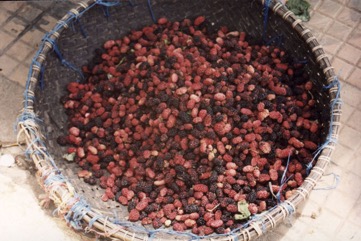
It grows in temperate Asia. It will grow on most types of soils. The soils need to be well-drained. The black mulberry will grow in colder places than the white mulberry. In PNG it grows best between 800-2,200 m above sea level. Hobart Botanical Gardens. It suits hardiness zones 5-10. Arboretum Tasmania.
Also known as:
Amora-preta, Amoreira nigra, Crna murva, Doce, Dut, Eksi karadut, Gelso, Haijampet, Hei sang, Kalo tut, Karadut, Ketsakhragu, Kimbu kafal, Kuro guwa, Mapulesi, Matibeni, Morera negra, Moro nero, Murbei hitam, Murier noir, Murva divlja, Shahtute, Shah-tut, Sicameno mavro, Teeth, Thor teeth, Tor thooth, Tor toot, Tuye
Synonyms
- See Streblus
Edible Portion
- Fruit, Leaves
Where does Persian mulberry grow?
Found in: Africa, Angola, Asia, Australia, Bahrain, Bangladesh, Bermuda, Brazil, Britain, Canada, Caucasus, China, Croatia, Cuba, Denmark, Dominican Republic, East Africa, Europe, France, Georgia, Germany, Greece, Haiti, Himalayas, India, Indonesia, Iran, Italy, Japan, Macedonia, Malawi, Malta, Mediterranean, Mexico, Nepal, North America, Northeastern India, NW India, Pacific, Pakistan, Papua New Guinea, PNG, Puerto Rico, Qatar, San Marino, Saudi Arabia, Scandinavia, SE Asia, Serbia, South Africa, Southern Africa, South America, Spain, St Helena, Sweden, Syria, Tanzania, Tasmania, Turkey, United States, West Africa, Zimbabwe
Notes: There are about 16 Morus species.
Status: They are sold in local markets. It is a cultivated food plant.
Growing Persian mulberry, Black mulberry
Cultivation: Plants can be grown from seed but such trees are very slow to grow and produce. It is grown by cuttings of 1-2 year old wood. Larger cuttings make faster growth. Cuttings are taken while trees are dormant in winter. Cuttings should be 1.5-2.5 cm across and 25-35 cm long. They need to be planted in sandy soil to half their depth. Grafted plants can also be used.
Edible Uses: The fruit are eaten. They can be eaten raw or preserved. They can be used for jams, jellies, and drinks. The leaves are used for sarma in Turkey. They are rolled around a filling of rice or minced meat.
Production: By putting a cloth under the tree and shaking the branches the fully ripe fruit fall.
Nutrition Info
per 100g edible portion| Edible Part | Energy (kcal) | Protein (g) | Iron (mg) | Vitamin A (ug) | Vitamin c (mg) | Zinc (mg) | % Water |
|---|---|---|---|---|---|---|---|
| Fruit | 43 | 1.4 | 1.9 | 3 | 36 | 0.1 | 87.7 |
Persian mulberry, Black mulberry Photos

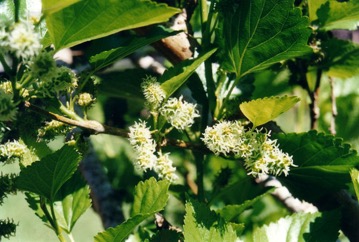
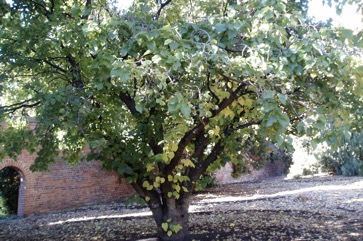
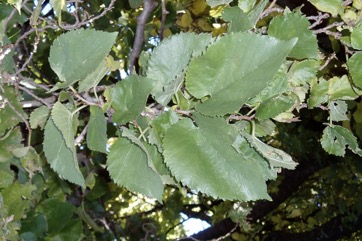
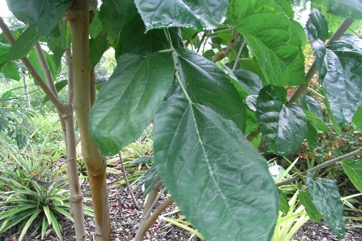
References
Afzal, S., et al, 2009, Ethno-botanical Studies from Northern Pakistan. J. Ayub Med Coll Abbottabad 21(1)
Ambasta, S.P. (Ed.), 2000, The Useful Plants of India. CSIR India. p 382
Arora, R. K., 2014, Diversity in Underutilized Plant Species - An Asia-Pacific Perspective. Bioversity International. p 78
Barkatullah, et al, 2009, Ethnobotanical studies of plants of Charkotli Hills, Batkhela District, Malakand, Pakistan. Front. Biol. China 2009, 4(4): 539–548
Barwick, M., 2004, Tropical and Subtropical Trees. A Worldwide Encyclopedic Guide. Thames and Hudson p 284
Bianchini, F., Corbetta, F., and Pistoia, M., 1975, Fruits of the Earth. Cassell. p 168
Bodkin, F., 1991, Encyclopedia Botanica. Cornstalk publishing, p 708
Bonet, M. A. & Valles, J., 2002, Use of non-crop food vascular plants in Montseny biosphere reserve (Catalonia, Iberian Peninsula). International Journal of Food Sciences and Nutrition (2002) 53, 225–248
Brickell, C. (Ed.), 1999, The Royal Horticultural Society A-Z Encyclopedia of Garden Plants. Convent Garden Books. p 683
Burkill, H. M., 1985, The useful plants of west tropical Africa, Vol. 4. Kew.
Chase, P. & Singh, O. P., 2016, Bioresources of Nagaland: A Case of Wild 4 Edible Fruits in Khonoma Village Forest. in J. Purkayastha (ed.), Bioprospecting of Indigenous Bioresources of North-East India. p 50
Cheifetz, A., (ed), 1999, 500 popular vegetables, herbs, fruits and nuts for Australian Gardeners. Random House p 209
Coombes, A.J., 2000, Trees. Dorling Kindersley Handbooks. p 220
Crawford, M., 2012, How to grow Perennial Vegetables. Green Books. p 136
Cundall, P., (ed.), 2004, Gardening Australia: flora: the gardener's bible. ABC Books. p 904
Dangol, D. R. et al, 2017, Wild Edible Plants in Nepal. Proceedings of 2nd National Workshop on CUAOGR, 2017.
Devi, O.S., P. Komor & D. Das, 2010, A checklist of traditional edible bio-resources from Ima markets of Imphal Valley, Manipur, India. Journal of Threatened Taxa 2(11): 1291-1296
Dogan, Y., et al, 2015, Of the importance of a leaf: the ethnobotany of sarma in Turkey and the Balkans. Journal of Ethnobiology and Ethnomedicine, 11:56
Dolina, K. & Luczaj, L., 2014, Wild food plants used on the Dubrovnik coast (south-eastern Croatia) Acta Soc Bot Pol 83(3):175–181
Esperanca, M. J., 1988. Surviving in the wild. A glance at the wild plants and their uses. Vol. 1. p 118
Etherington, K., & Imwold, D., (Eds), 2001, Botanica's Trees & Shrubs. The illustrated A-Z of over 8500 trees and shrubs. Random House, Australia. p 483
Facciola, S., 1998, Cornucopia 2: a Source Book of Edible Plants. Kampong Publications, p 155
Farooq, S., et al, 2012, Ethnobotanical Studies of the Flora of Tehsil Birmal in South Waziristan Agency, Pakistan. Pak. J. Weed Sci. Res. 18(3): 277-291
Flora of China @ efloras.org Volume 5
Flowerdew, B., 2000, Complete Fruit Book. Kyle Cathie Ltd., London. p 52
Gunes, S. et al, 2018, Survey of wild food plants for human consumption in Karaisali (Adana-Turkey). Indian Journal of Traditional Knowledge. Vol. 17(2), April 2018, pp 290-298
Gurdal, B. & Kultur, S., 2014, The edible and miscellaneous useful plants in Marmaris (Southwest Turkey). İstanbul Ecz. Fak. Derg. / J. Fac. Pharm. Istanbul 44(1) 2014 pp.69-78
Hearne, D.A., & Rance, S.J., 1975, Trees for Darwin and Northern Australia. AGPS, Canberra p Pl 24
Hedrick, U.P., 1919, (Ed.), Sturtevant's edible plants of the world. p 421
Heywood, V.H., Brummitt, R.K., Culham, A., and Seberg, O. 2007, Flowering Plant Families of the World. Royal Botanical Gardens, Kew. p 218
Hibbert, M., 2002, The Aussie Plant Finder 2002, Florilegium. p 199
Hu, Shiu-ying, 2005, Food Plants of China. The Chinese University Press. p 362
Janaćković, P. et al, 2019, Traditional knowledge on plant use from Negotin Krajina (Eastern Serbia): An ethnobotanical study. Indian Journal of Traditional Knowledge Vol 18 (1), pp 25-33
Jardin, C., 1970, List of Foods Used In Africa, FAO Nutrition Information Document Series No 2.p 148
John, L., & Stevenson, V., 1979, The Complete Book of Fruit. Angus & Robertson p 197
Kargioglu, M. et al, 2010, Traditional Uses of Wild Plants in the Middle Aegean Region. Human Ecology 38:429-450
Kayabasi, N. P., et al, 2018, Wild edible plants and their traditional use in the human nutrition in Manyas (Turkey). Indian Journal of Traditional Knowledge. Vol. 17(2), April 2018, pp 299-306
Khan, D. & Shaukat, S.S., 2006, The Fruits of Pakistan: Diversity, Distribution, Trends of Production and Use. Int. J. Biol. Biotech., 3(3):463-499
Khan, M. & Hussain, S., 2014, Diversity of wild edible plants and flowering phenology of district Poonch (J & K) in the northwest Himalaya. Indian Journal of Sci, Res. 9(1): 032-038
Kiple, K.F. & Ornelas, K.C., (eds), 2000, The Cambridge World History of Food. CUP p 1817
Kizilarslan, C. & Ozhatay, N., 2012, An ethnobotanical study of the useful and edible plants of İzmit. Marmara Pharmaceutical Journal 16: 134-140, 2012.
Lautenschläger, T., et al, 2018, First large-scale ethnobotanical survey in the province of Uíge, northern Angola. Journal of Ethnobiology and Ethnomedicine (2018) 14:51
Lazarides, M. & Hince, B., 1993, Handbook of Economic Plants of Australia, CSIRO. p 166
Lentini, F. and Venza, F., 2007, Wild food plants of popular use in Sicily. J Ethnobiol Ethnomedicine. 3: 15
Little, E. L., et al, 1974, Trees of Puerto Rico and the Virgin Islands. USDA Handbook 449. Forestry Service. p 140
Lord, E.E., & Willis, J.H., 1999, Shrubs and Trees for Australian gardens. Lothian. p 62
Lorenzi, H., Bacher, L., Lacerda, M. & Sartori, S., 2006, Brazilian Fruits & Cultivated Exotics. Sao Paulo, Instituto Plantarum de Estuados da Flora Ltda. p 442
Macmillan, H.F. (Revised Barlow, H.S., et al) 1991, Tropical Planting and Gardening. Sixth edition. Malayan Nature Society. Kuala Lumpur. p 316
Maghradze, D. et al, 2012, Minor and Underutilized Fruits in Georgia and Their Wild Relatives. In Acta Horticulturae Number 948 p 41-47
Mbuya, L.P., Msanga, H.P., Ruffo, C.K., Birnie, A & Tengnas, B., 1994, Useful Trees and Shrubs for Tanzania. Regional Soil Conservation Unit. Technical Handbook No 6. p 352
Miguel, E., et al, 1989, A checklist of the cultivated plants of Cuba. Kulturpflanze 37. 1989, 211-357
Moerman, D. F., 2010, Native American Ethnobotany. Timber Press. p 350
Nebel, S., Pieroni, A. & Heinrich, M., 2006, Ta cho`rta: Wild edible greens used in the Graecanic area in Calabria, Southern Italy. Appetite 47 (2006) 333–342
Norrington, L., & Campbell, C., 2001, Tropical Food Gardens. Bloomings Books. p 109
Norton, J., et al, 2009, An Illustrated Checklist of the Flora of Qatar. UNESCO Office in Doha.
Pasha, M. K. & Uddin, S. B., 2019, Minor Edible Fruits of Bangladesh. Bangladesh J. Plant Taxon. 26(2): 299–313
Özdemir, E. and Kültür, S., 2017, Wild Edible Plants of Savaştepe District (Balıkesir, Turkey), Marmara Pharm J 21/3: 578-589
Peekel, P.G., 1984, (Translation E.E.Henty), Flora of the Bismarck Archipelago for Naturalists, Division of Botany, Lae, PNG. p 132, 133
Pieroni, A., 1999, Gathered wild food plants in the Upper Valley of the Serchio River (Garfagnana), Central Italy. Economic Botany 53(3) pp 327-341
Pieroni, A., et al, 2005, Food for two seasons: Culinary uses of non-cultivated local vegetables and mushrooms in a south Italian village. International Journal of Food Sciences and Nutrition, 56(4): 245-272
Plants for a Future database, The Field, Penpol, Lostwithiel, Cornwall, PL22 0NG, UK. http://www.scs.leeds.ac.uk/pfaf/
Polat, R., et al, 2015, Survey of wild food plants for human consumption in Elazig (Turkey). Indian Journal of Traditional Knowledge. Vol. 1(1): 69-75
Polat, R., et al, 2017, Survey of wild food plants for human consumption in Bingol, (Turkey). Indian Journal of Traditional Knowledge. Vol. 16(3) July 2017, pp. 378-384
Rashid, A., Anand, V.K. & Serwar, J., 2008, Less Known Wild Plants Used by the Gujjar Tribe of District Rajouri, Jammu and Kashmir State. International Journal of Botany 4(2):219-244
Recher, P, 2001, Fruit Spirit Botanical Gardens Plant Index. www.nrg.com.au/~recher/ seedlist.html p 2
Ruiters-Welcome, A. K., 2019, Food plants of southern Africa. Ph.D. thesis. Univ. of Johannesburg p 80
Schuler, S., (Ed.), 1977, Simon & Schuster's Guide to Trees. Simon & Schuster. No. 137
Segura, S., et al, 2018, The edible fruit species in Mexico. Genet Resour Crop Evol (2018) 65:1767–1793
Self, M., 199, Phoenix Seeds catalogue. p 16
Sharma, B.B., 2005, Growing fruits and vegetables. Publications Division. Ministry of Information and broadcasting. India. p 94
Sher, H. et al, 2011, Ethnobotanical and Economic Observations of Some Plant Resources from the Northern Parts of Pakistan. Ethnobotany research & Applications 9:027-041
Smith, P.M., 1979, Mulberry, in Simmonds, N.W., (ed), Crop Plant Evolution. Longmans. London. p 316
Sp. pl. 2:986. 1753
Sukarya, D. G., (Ed.) 2013, 3,500 Plant Species of the Botanic Gardens of Indonesia. LIPI p 678
Swaminathan, M.S., and Kochnar, S.L., 2007, An Atlas of major Flowering Trees in India. Macmillan. p 248
Uprety, Y., et al, 2012, Diversity of use and local knowledge of wild edible plant resources in Nepal. Journal of Ethnobotany and Ethnomedicine 8:16
USDA, ARS, National Genetic Resources Program. Germplasm Resources Information Network - (GRIN). [Online Database] National Germplasm Resources Laboratory, Beltsville, Maryland. Available: www.ars-grin.gov/cgi-bin/npgs/html/econ.pl (10 April 2000)
van Wyk, B., 2005, Food Plants of the World. An illustrated guide. Timber press. p 255
Williamson, J., 2005, Useful Plants of Malawi. 3rd. Edition. Mdadzi Book Trust. p 169
World Checklist of Useful Plant Species 2020. Royal Botanic Gardens, Kew
www.eFloras.org. Flora of China
www.worldagroforestrycentre.org/treedb/